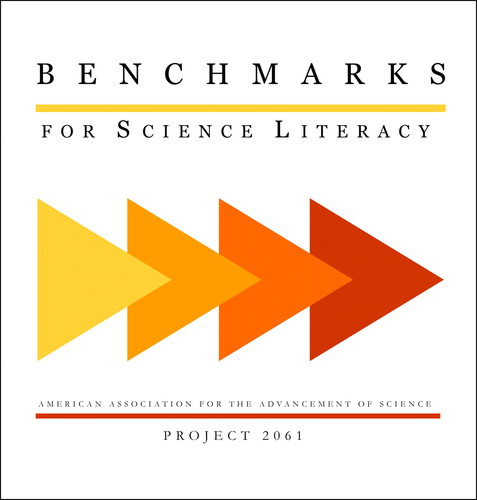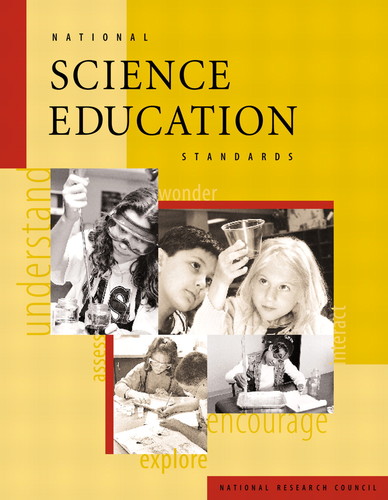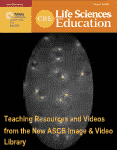National and State Standards in Science and Their Potential Influence on Undergraduate Science Education
INTRODUCTION
Standards in science and other subjects are a recent phenomenon in education, with most of them having been developed within the past 15 years. In 2002, Kimberly Tanner and Deborah Allen published in the first volume of Cell Biology Education (CBE) an important article about national science education standards for Grades K–12. That article likely provided for many readers of CBE their first glimpse of the standards movement in K–12 education and the potential impact of standards on higher education. The article focused on the two national science standards documents, Benchmarks for Science Literacy, published by the American Association for the Advancement of Science (AAAS; 1993), and the National Science Education Standards, published by the National Research Council (NRC; 1996), and what those standards specify about what students should know and be able to do at various grade levels in cell biology. Tanner and Allen (2002) also provided what have turned out to be some prescient ideas and questions about the more general roles of science standards in education in the United States.
Much has happened in K–12 education during the past four years and, for the following reasons, an update on the standards movement is warranted.
Tanner and Allen reported how the national documents were designed to serve as guidelines for the development of state standards and pointed out some of the issues involved in translating the national standards to state frameworks. In the four years since Tanner and Allen published their article, all states except Iowa have developed their own standards. Indeed, some states are now in a cycle of revising their standards documents.
During the past five years, the federal No Child Left Behind Act (NCLB) has become much more a part of the fabric of K–12 education. Most people who are familiar with this legislation identify it with new expectations for testing and accountability. What is less known is that states are also required to align standardized assessments and classroom instruction with their standards documents.
To date, students have been tested only in reading and mathematics as part of NCLB. Science will be tested for the first time during the 2007–2008 school year. Thus, science will take on a much greater level of importance in public education in the ensuing years, and this increased attention could have important ramifications for higher education in the sciences.
A BRIEF HISTORY
Beginning with a historic conference of the National Governors Association and continuing into the early 1990s, President George H.W. Bush and the nation's governors developed the National Education Goals (sometimes referred to as “Goals 2000”).2 Eight goals were articulated; goal 4 declared that by the year 2000, “U.S. Students will be first in the world in mathematics and science achievement.” To achieve this goal, the governors decided that national standards for science and other subjects should be developed.3 For science, the governors declared the following objectives.
Students in Grades K–12 will
Use scientific principles and processes appropriately in making personal decisions. | |||||
Experience the richness and excitement of knowing about and understanding the natural world. | |||||
Increase their economic productivity. | |||||
Engage intelligently in public discourse and debate about matters of scientific and technological concern. | |||||
Be aware of careers in science, technology, and the medical sciences. | |||||
These principles suggested approaches to science education that were very different from the prevailing teaching methods in several fundamental ways. First, instead of focusing almost exclusively on facts, these objectives also called for educating students to understand the connections between science and other types of knowledge and how science is relevant to their lives and their communities. Second, rather than emphasizing science education primarily for those students who were most likely to pursue careers in science or engineering (as had been promulgated in the post-Sputnik era), these objectives emphasized science education and scientific literacy for all students. Last, science was to be introduced to students much earlier in their academic preparation than was typical.
All of these changes had clear implications for the education and ongoing professional development of teachers, the numbers of teachers able to teach science, curriculum development and implementation, and even the physical spaces in which science would be taught. Clearly, some guidance was needed to help state education departments as well as local school districts and school personnel implement such sweeping changes in precollege science education.
This new perspective on science education was influenced greatly by the publication of Science for All Americans (Rutherford and Ahlgren, 1990) by AAAS. In response to both this publication and the directives of the National Governors Association, both AAAS and the NRC began work on producing national standards for science. AAAS' Benchmarks for Science Literacy (Figure 1) were published in 1993 (AAAS, 1993) and focused on content standards.

Figure 1. Cover of Benchmarks.
The NRC released the National Science Education Standards (NSES) in 1996 (Figure 2). These standards deliberately embedded science content standards within a larger system of science education, thereby emphasizing that gains in student performance are dependent upon improvements in the entire system of science education and not solely on enhancements in content standards. Consequently, the NSES called for changes in six sectors of the education system that would be required to realize sustained improvements in student performance:
Teaching
Professional development for teachers
Assessment
Content
Science education programs
Science education systems

Figure 2. Cover of NSES.
| AAAS Benchmarks | NSES |
|---|---|
| The Nature of Science | |
| The Nature of Mathematics | |
| The Nature of Technology | Science and Technology |
| The Physical Setting | Physical/Earth/Space Sciences |
| The Living Environment | Life Sciences |
| The Human Organism | Science in Personal/Social Perspectives |
| Human Society | |
| The Designed World | |
| The Mathematical World | |
| Historical Perspectives | History and Nature of Science |
| Common Themes | Unifying Concepts and Processes |
| Habits of Mind | Science as Inquiry |
The NSES call for a very different way of presenting content and assessing students' knowledge of science (Tables 2 and 3). The NSES view science education as something that students “do,” rather than something that is “done to them.” There is greater emphasis on integrating the processes and nature of science with content knowledge in the various scientific disciplines as a student progresses from the elementary through the secondary grades.
| Less emphasis on | More emphasis on |
|---|---|
| Knowing scientific facts and information | Understanding science processes and developing abilities of inquiry |
| Studying subject matter disciplines (e.g., physics, earth sciences) for their own sake | Learning subject matter disciplines in the context of inquiry, technology, science in personal and social perspectives, and history and nature of science |
| Separating science knowledge and science process | Integrating all aspects of science content |
| Covering many science topics | Studying a few fundamental science concepts |
| Implementing inquiry as a set of processes | Implementing inquiry as instructional strategies, abilities, and ideas to be learned |
| Less emphasis on | More emphasis on |
|---|---|
| Assessing what is easily measured | Assessing what is most highly valued |
| Assessing discrete knowledge | Assessing rich, well-structured knowledge |
| Assessing scientific knowledge | Assessing scientific understanding and reasoning |
| Assessing to learn what students do not know | Assessing to learn what students do understand |
| Assessing only achievement | Assessing achievement and opportunity to learn |
| End-of-term assessments by teachers | Students engaged in ongoing assessment of their work and that of others |
| Development of external assessments by measurement experts alone | Teachers involved in the development of external assessments |
Not all content is of equal importance. Consequently, both the NSES and the Benchmarks stress that students will gain a deeper understanding and appreciation of science if they cover fewer topics and instead uncover some in greater depth, i.e., “less is more.”
The NSES also call for fundamental changes in what teachers should know and be able to do (Table 4), especially for elementary and middle school teachers who increasingly are becoming teachers of science. These recommendations suggest that new and very different approaches to teacher preparation and ongoing professional development are needed.
| Standard | Excerpt |
|---|---|
| A | The professional development of teachers of science requires learning science content through the perspectives and methods of inquiry … |
| B | Professional development of teachers of science requires integrating knowledge of science, learning, pedagogy and students, applying that understanding to science teaching … |
| C | The professional development of teachers of science enables them to build the knowledge, skills, and attitudes needed to engage in lifelong learning … |
| D | Pre-service and in-service professional development programs for teachers are coherent and integrated … |
Since the publication of the Benchmarks and the NSES, both the AAAS and the NRC have published supplements to their original documents. AAAS has released several publications that focus on how to use the Benchmarks and the implications of their use in schools. An especially useful supplement is AAAS' Atlas of Science Literacy (AAAS, 2001)5 that helps educators identify prerequisite knowledge and understanding in the content disciplines addressed by the Benchmarks that students need to study grade-level-appropriate material and to be prepared to progress to more advanced materials. The Benchmarks and all of these supplemental publications are available at http://www.project2061.org/.
Supplements to the NSES have focused on broader systems issues, including helping teachers understand the nature of inquiry (NRC, 2000), classroom assessment (NRC, 2001a), designing standards-based mathematics or science curricula (NRC, 1999), a framework for research efforts to investigate the efficacy of standards (NRC, 2001b), and a publication to help parents of school-age children and the general public understand the changes being promoted by the NSES (NRC, 1997).
STATE-BASED IMPLEMENTATION OF NATIONAL STANDARDS
National Standards Are Not Federal Standards
There are no mandated national standards for any subject in Grades K–12 in the United States. The responsibility for precollege education is vested constitutionally with state and local authorities. The Federal Government contributes approximately 8% of the total budget for K–12 education. Thus, the Benchmarks, NSES, and other national standards documents that were produced at the same time as, and subsequent to, these documents6 are intended to serve as guides that states can use to voluntarily develop and implement their own standards. However, when published the NSES represented a national consensus of the scientific and science education communities of what constitutes quality science education and the educational systems needed to support that education. They were reviewed by thousands of scientists and science educators and by dozens of professional societies before their release.
State standards are now the predominant influence on K–12 education, and there is considerable variation from state to state in their use of the NSES and the Benchmarks and in their adjudged quality (e.g., Gross et al., 2005). As a specific example, evolution is a subject that has received considerable attention by the media, policy makers, and the public in both national standards documents. Some states have adopted these recommended standards faithfully, whereas others have eliminated selected components or do not mention evolution at all (Lerner, 2000; Gross et al., 2005). In other cases, there has been great controversy about the amount of content that students should be required to know and at what grade levels they are expected to know it. Political and other considerations continue to influence the state-based adoption process as individual states revise their standards every five to seven years.7
The proliferation of state standards has resulted in some unintended consequences. For example, science textbook publishers and curriculum developers who previously only had to show that their products were consistent with one or both national standards documents to be adopted now have to tailor their products to the many different state standards to be considered. Such pressures can lead to fragmentation of content or production of textbooks that respond to the “lowest common denominator.”
During the past few years, state standards also have taken on increasing prominence because of NCLB, which mandates that students be tested on content that is tied to a state's standards in a particular discipline. Each state must administer tests aligned to those standards. However, since the law's inception, schools have only been held accountable for testing and demonstrating adequate yearly progress8 in reading and mathematics, and only for Grades 3–8 in these subjects. Science will be tested beginning in the 2007–2008 school year and then only in each grade band corresponding to the elementary, middle, and secondary grades.
There are three important consequences of this process that should concern scientists and science educators:
In some districts teachers, especially in the elementary grades, have been asked to reduce or eliminate the teaching and learning of science to allow more time for preparation in reading and mathematics. Districts often do not embrace the interdisciplinary concept that science can serve as an effective vehicle for learning of mathematics and development of reading skills, both essential for successful performance in science. Consequently, reduction in class time doing science may result in a cohort of students who are ill-prepared to appreciate and succeed in science when testing does begin.
When science is finally tested in 2007–2008, or when districts recognize that they have to begin preparing students for the science examinations, they will rely heavily, if not exclusively, on their state science standards, which often reinforce the learning of facts rather than the more systemic and integrative approaches that are emphasized by the NSES and the Benchmarks. Unless state standards both require and reinforce the notion that quality science education also includes exploration, data analysis, and developing deep conceptual understanding of topics, teachers will be under pressure to focus primarily on factual information, lower-level thinking skills, and limited conceptual understanding. Moreover, these conditions suggest that teachers and school administrators will tend to focus on the specific content and examples that are planned for the assessment.
NCLB permits individual states to use any assessment instruments they wish as long as they align with that state's content standards. However, assessments that authentically measure students' deep conceptual understanding, their skill and ability to explore, transfer knowledge from one topic to another, and to synthesize and draw conclusions from data are more expensive and difficult to develop, administer, and score than tests that focus on factual knowledge. Thus, there likely will be strong financial pressure to use the less expensive, less rigorous instruments that are currently available. These kinds of assessments would send strong messages about the kind of science education that is valued and could reverse some of the gains that are beginning to be reported around the country. The NRC has published several reports that focus on these issues (NRC, 2001c, 2003, 2005).
College-level scientists can become engaged with these efforts in many ways. For example, they can work with state boards of education to review science standards in their specific disciplines or more broadly when those standards are being revised. They can work locally on selection committees for textbooks and other science education resources to help district leaders, administrators, and teachers determine whether those resources conform to state standards and meet the need for high-quality materials. As parents, grandparents, and citizens, scientists can play important roles in their schools and communities as advocates for high-quality science teaching and learning for all students.
The focus, quality, and effectiveness of today's science education programs ultimately will result in college students who are or are not prepared to engage in science at the postsecondary level. Thus, postsecondary educators have a vital long-term stake and self-interest in today's K–12 science education programs and the policies that govern them. Higher education has had little influence to date on the development or implementation of standards because scientists have not been well represented at the table at either the district or state levels. For all the reasons outlined above, the time to do so is now.
FOOTNOTES
1 Adapted with permission from an article published in Marine Technology Society Journal, Winter 2005/2006, 15–19. The Marine Technology Society is a not-for-profit, international, professional association. Founded in 1963, the society believes that the advancement of marine technology and the productive, sustainable use of the oceans depend upon the active exchange of ideas between government, industry, and academia. See http://www.mtsociety.org.
2 For additional information on Goals 2000, see http://www.ed.gov/G2K/index.html.
3 Standards for mathematics had already been developed by the National Council of Teachers of Mathematics and released in 1989. These mathematics standards were revised and updated in 2000. For more information, see National Council of Teachers of Mathematics (1989, 2000). In 2000, the International Technology Education Association also published the Standards for Technological Literacy: Content for the Study of Technology. See References for additional information.
4 The Benchmarks specify four grade bands: Grades K–2, 3–5, 6–8, and 9–12. The NSES specify three grade bands: Grades K–3, 4–8, and 9–12.
5 AAAS is currently preparing a second volume of the Atlas. Additional information and samples from the new volume are available at http://www.project2061.org/publications/atlas/vol2/default.htm.
6 For example, in 2000 the International Technology Education Association published Standards for Technological Literacy (International Technology Education Association, 2000). See http://www.iteaconnect.org/TAA/TAA.html.
7 See, for example, the controversy that has arisen in California at http://www.sci-ed-ga.org/standards/analysis.html.
8 For more information from the U.S. Department of Education about this component of the law, see http://www.ed.gov/nclb/accountability/ayp/yearly.html.
9 Access to individual state standards is available through a state's Department of Education or through http://www.education-world.com/standards/state/index.shtml.



